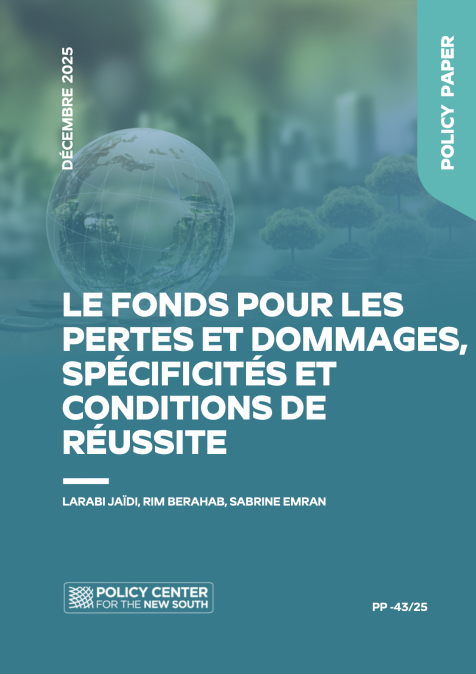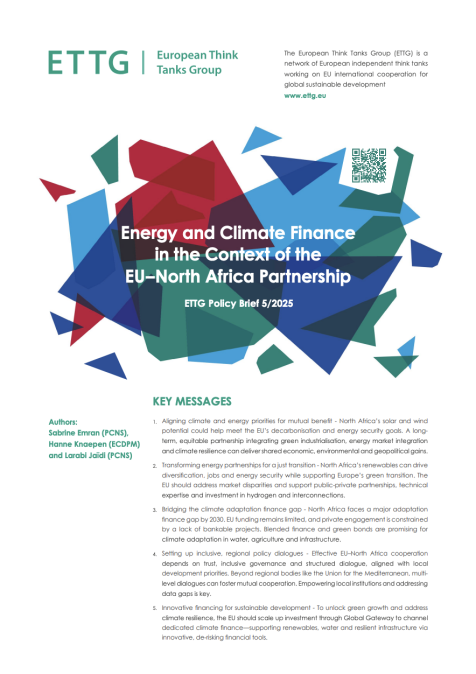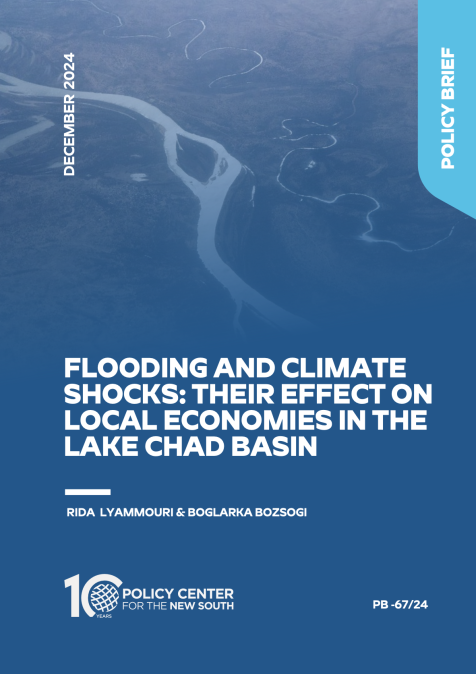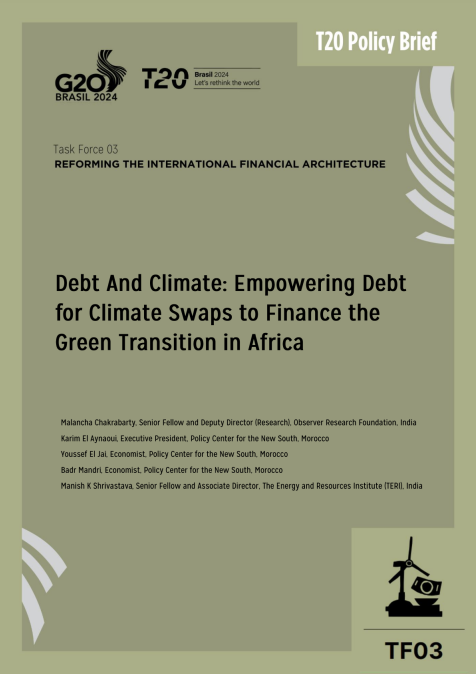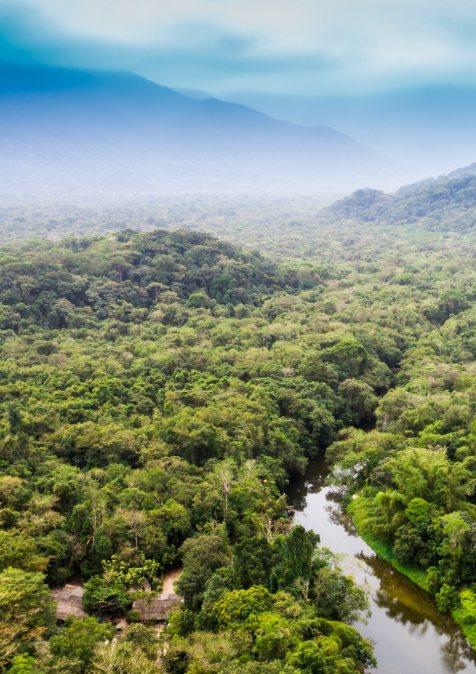Publications /
Opinion
This Blog was originally published on ettg.eu
Europe and North Africa are intensifying cooperation, driven by shared interests in renewable energy deployment, trade and industrialisation. This renewed focus is opening doors for deeper energy partnerships, including on green hydrogen, and offers North African countries new opportunities to expand into European markets. At the same time, it raises concerns about the uneven distribution of benefits and insufficient international finance for climate adaptation in the region. The challenge now is to turn this evolving relationship into a long-term alliance that supports green industrialisation, fair climate action and mutual resilience.
Challenges for a just transition
North Africa’s vast renewable energy potential is key to its economic transformation and industrial growth, while also supporting Europe’s green transition. Strengthened EU–North Africa cooperation could unlock a more balanced and equitable energy partnership across the region. Morocco and Egypt, for instance, are advancing green industrialisation and hydrogen production, with both countries receiving significant investment through the EU’s Global Gateway strategy since 2023, reflecting shared energy transition goals. For example, Morocco is partnering with the EU on green hydrogen, as part of a €624 million package announced, while Egypt has attracted over €1 billion in green hydrogen project commitments with European partners.
However, the expansion of export-led renewables risks fuelling competition among North African countries for EU funding, infrastructure investment and market access. There is a growing need to deepen economic ties so that North Africa becomes not just a supplier of raw energy, but a green manufacturing hub in its own right. Europe sees North Africa as a strategic supplier of hydrogen via cost-efficient pipelines. However, North African countries face significant challenges in exporting green hydrogen, including the high cost and technical complexity of repurposing or building new transport infrastructure. These constraints – along with limited grid capacity, renewable energy intermittency, and substantial water requirements – are slowing progress and raising questions about long-term viability.
Therefore, some argue that importing hydrogen-derived industrial materials, such as green iron, could prove more practical and mutually beneficial. These uncertainties, combined with concerns over EU trade measures like the Carbon Border Adjustment Mechanism (CBAM), which imposes a levy on imports like iron and steel, fertilisers, electricity and hydrogen, underscore tensions around fairness and reciprocity in the evolving partnership.
The climate adaptation finance gap
While energy cooperation accelerates – North Africa has increased its renewable energy production by over 40% in the past decade – the region remains highly vulnerable to climate shocks. Rising temperatures and declining rainfall threaten water and food security, yet adaptation finance remains critically low. Morocco, Tunisia and Egypt face a projected $89.3 billion adaptation gap by 2030. However, despite ambitious policy commitment, the EU disbursed only €67.1 million for adaptation efforts in these three countries between 2010 and 2021. This limited disbursement reflects a broader trend of underfunding for climate adaptation by international actors in the region.
Generally, most available climate adaptation finance in the region comes as loans (for example, 53% for the period 2019-2020), adding to public debt burdens, often on restrictive terms – exacerbating structural barriers to a just transition. In other words, high capital costs and limited concessional finance slow progress. In addition, broader geopolitical tensions, ranging from protectionist trade policies to shrinking development aid, add even more pressure.
This is concerning as investments in climate adaptation are critical for regional resilience to climate shocks, mitigating risks that could otherwise exacerbate instability and unsafe migration or affect food supply chains, if root causes are not addressed properly. The EU’s recent migration agreements with Egypt and Tunisia, for instance, focus on border security and reducing irregular migration, overlooking climate change as a migration driver in the region.
Pathways towards transformative cooperation
Just two weeks ago, the EU released its Preparedness Union Strategy to increase Europe’s ability to prevent and respond to emerging threats. It explicitly highlights the need to strengthen resilience against “the growing pressure from the negative impact of climate change in other parts of the world” and acknowledges the deep links between climate, environment and security – signalling growing recognition that supporting adaptation abroad is key to Europe’s own preparedness. Concretely, this could include building resilience, diversifying and integrating supply chains through free trade agreements, clean trade and investment partnerships and strategic partnerships on raw materials.
To also scale up climate adaptation finance, it will be key to shift from debt-heavy models to blended finance and green bonds and ensure support from institutions like the World Bank’s International Development Association and public development banks. Technical assistance from bodies like the International Development Finance Club (IDFC), which has committed to aligning financial flows with the Paris Agreement, or the Task Force on Climate-related Financial Disclosures (TCFD), which has developed widely adopted climate risk reporting frameworks, can also help build capacity and drive inclusive progress. For instance, IDFC members have collectively committed over $150 billion annually to climate finance, including growing efforts on adaptation, while TCFD’s recommendations have guided public development banks in integrating climate risk into investment decision-making.
The creation of the EU’s new Directorate-General for the Middle East, North Africa, and the Gulf (DG MENA) presents a timely opportunity to establish a more structured and strategic EU–North Africa dialogue. Emerging frameworks – such as the proposed new Pact for the Mediterranean and the EU-led Trans-Mediterranean Energy and Clean Tech Cooperation Initiative – could help integrate energy trade, green industrialisation and climate finance in ways that serve both regions. These platforms may also ease tensions around EU measures like the CBAM by coupling them with targeted financial support to address potential disparities.
As the EU advances its Clean Industrial Deal, there is a real opportunity to turn evolving interdependencies into a win-win partnership – building a more integrated net-zero industrial geography with its neighbours. This means not just securing supply chains and reducing costs, but also opening new markets for low-carbon goods. Projects like TeraMed are paving the way toward a more connected and sustainable Mediterranean energy system. At the same time, aligning energy transitions with climate resilience, particularly in sectors like agriculture, can help improve productivity and long-term sustainability.
A mutually beneficial partnership requires EU strategies to align closely with partner country ambitions. For instance, Morocco’s Offre du Maroc programme seeks to position the country as a green hydrogen leader, while Egypt’s participation in the H2Global auction signals growing momentum toward a shared hydrogen economy. However, for both Europe and North Africa, delivering equitable outcomes from this transition will require substantial and sustained investment, responsive to local needs.
Practically, this includes combining investment tools, such as blended finance, risk-sharing guarantees or green bonds, with stronger bilateral cooperation, innovation, and green skills exchange. It also must go hand in hand with addressing risks, building trust, and ensuring a just transition through capacity building, technology transfer, and scaled-up, accessible and concessional adaptation finance and fairer financial terms. Without such an integrated approach, regional resilience and mutually beneficial, transformative cooperation will remain out of reach.


